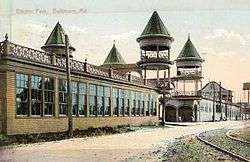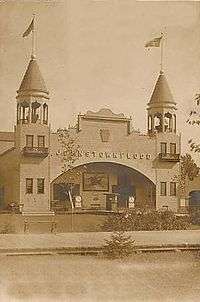Electric Park
Electric Park was a name shared by dozens of amusement parks in the United States that were constructed as trolley parks and owned by electric companies and streetcar companies.[1] After 1903, the success of Coney Island inspired a proliferation of parks named Luna Park and Electric Park,[2] while the World's Columbian Exposition of 1893 inspired the formation of White City amusement parks at roughly the same time. The existence of most of these parks was generally brief: the bulk of them closed by 1917, the year of the United States' entry into World War I. Many pavilions have outlasted the parks themselves, with a few of them still standing today.
Electric Parks

The emergence of trolley parks in the last dozen years of the 19th century coincided with the rise to prominence of three entities: the electric companies (which grew rapidly as much of the United States was undergoing electrification since the 1880s), the railway companies (which constructed new interurban rail lines mainly in the eastern half of the U. S.), and - starting about 1890 - the replacement of horse-drawn cars by electric trolley companies. A fourth contributor to the rise in amusement parks in the first decade of the 20th century was the success of Coney Island,[2] which spurred the establishment of dozens of Electric Parks, Luna Parks, and White City amusement parks (the latter actually inspired by White City in the 1893 World's Columbian Exhibition in Chicago), with many metropolitan areas having two (or more) parks with these names.
Most Electric Parks were owned by electric companies and trolley companies, which often had one or more lines that transported workers and shoppers between the downtown areas of the various cities and residential and industrial areas. (After 1900, interurban electric rail lines began carrying commuters from one city to another). Originally, the trolleys and interurban lines would either operate at a reduced level on weekends or be completely idle. To generate weekend traffic, the companies eventually created new destinations, generally at the end of their lines, for the public to attend on the weekends, whether it be a picnic park or (later) an amusement park.[2] Regardless of the type of park, the destinations owned by the local electric company or accessed by the electric trolley were commonly called electric parks. After 1903, Luna Park in Coney Island's success (with the park's entrance decked with electric lights) inspired the creation of Electric Parks, which spread throughout North America (at the same time, the similarly-inspired Frederick Ingersoll started to construct his Luna Park empire).
Like their Luna Park and White City cousins, a typical Electric Park featured a shoot-the-chutes and lagoon, a roller coaster (usually a figure eight or a mountain railway), a midway, a Ferris wheel, games, and a pavilion. Most also had miniature railroads. Many cities had two (or all three) of the Electric Park/Luna Park/White City triumvirate in their vicinity... with each trying to outdo the others with new attractions, with many incorporating an exhibit simulating the Johnstown Flood of 1889. The competition was fierce, often driving the electric parks out of business with increasing costs of equipment upgrades, upkeep, and insurance. More than a few succumbed to fire. As a result, most were out of business by 1917, the year the United States entered World War I. By the time troops returned to the U.S. (in 1919), almost all the Electric Parks were gone.
List of Electric Parks
While the date and location of the first Electric Park is currently unknown,[3] several existed before 1900. Since then, dozens of amusement parks had acquired the name:
- Electric Park, Aberdeen, Washington
- Electric Park, Albany, New York (1901-?),[4] also known as White City
- Electric Park, Atlanta, Georgia[3]
- Electric Park, Baltimore, Maryland (June 1896 – 1916)[5][6][7][8]
- Electric Park, Bellingham, Washington[3]

- Electric Park, Binghamton, New York[3]
- Electric Park, Blackwood, Oklahoma - pavilion still stands, listed on the National Register of Historic Places
- Electric Park, Cleveland, Ohio[3]
- Electric Park, Dayton, Ohio[3]
- Electric Park, Detroit, Michigan (26 May 1906 – 1928), went through several names in its existence, including Luna Park[9][10]
- Electric Park, Eau Claire, Wisconsin (1895 – c. 1926) - park adjacent to nearby Lake Halle; closed after Chippewa Valley Electric Railway ceased operations 1 September 1926
- Electric Park, Fort Smith, Arkansas (1905–1920)[11]
- Electric Park, Galveston, Texas (1905-?)
- Electric Park, Hancock, Michigan (7 June 1906- c. 1933) - originally Anwebida ("Let us rest here" in Chippewa)[12][13][14]
- Electric Park, Holland, Michigan, also known as Jenison Electric Park[15][16]
- Electric Park, Houston, Texas[17]
- Electric Park, Iola, Kansas (ca. 1901–1918),[18] also known as "Iola Electric Park"
- Electric Park, Joplin, Missouri (10 June 1909 – 1912)[19] - now part of Schifferdecker Park
- Electric Park, Kansas City, Missouri (1907–1925)[20] - second Electric Park by the Heim Brothers, who opened their first Electric Park in 1899, adjacent to their Kansas City brewery[21]
- Electric Park, Louisville, Kentucky[3][22][23]
- Electric Park, Montgomery, Alabama[24]
- Electric Park, New Haven, Connecticut[25]
- Electric Park, Newark, New Jersey (1903–1912) park that is now the site of Vailsburg Park[26][27]
- Electric Park, Niagara Falls, New York[24]
- Electric Park, Oshkosh, Wisconsin (1898 – c. 1950),[3] also called White City and EWECO Park
- Electric Park, Pensacola, Florida (1905-?)[28]
- Electric Park, Pittsburgh, Pennsylvania
- Electric Park, Plainfield, Illinois (1904–1932);[29] auditorium became a dance hall and then a skating rink (both roller and ice) until destroyed by tornado in 1990[30]
- Electric Park, Pottsville, Pennsylvania - also called Electric Park Philadelphia[3]
- Electric Park, St. Louis, Missouri in Creve Coeur Park[31]
- Electric Park, San Antonio, Texas[32] - currently the site of minor league baseball park of same name
- Electric Park, Sheboygan, Wisconsin[3]
- Electric Park, Springfield, Missouri[3] - may be same as Joplin Electric Park
- Electric Park, Syracuse, New York[3]
- Electric Park, Tulsa, Oklahoma (1921 – c. 1926)- merged into Crystal City Amusement Park in mid 1920s [33]
- Electric Park, Waterloo, Iowa - had unique water-turned ferris wheel;[34] pavilion still standing
- Electric Park, Worcester, Massachusetts[3]
See also
- Tucson Electric Park, baseball stadium in Tucson, Arizona
References
- ↑ "Listing of Stan Kujawa's Electric Park Summer Resort & Amusement Park 1905-1920". Roller Coaster Media Library.
- 1 2 3 Samuelson, Dale; Samuelson, A.J.P.; Yegoiants, Wendy (2001). The American Amusement Park. MBI Publishing Company. ISBN 0-7603-0981-7.
- 1 2 3 4 5 6 7 8 9 10 11 12 13 Samuelson, Dale; Samuelson, A.J.P.; Yegoiants, Wendy. The American Amusement Park. ISBN 0-7603-0981-7.
- ↑ "Electric Park Era - Kinderhook Lake".
- ↑ "Wild Ride". Baltimore Style Magazine. July–August 2007.
- ↑ "Pictures". Kilduffs.com.
- ↑ Maryland's Amusement Parks – via Google Books.
- ↑ Headley, Robert K. (2008). Maryland's Motion Picture Theaters. Arcadia Publishing. ISBN 0-7385-5384-0.
- ↑ Detroit News. 6 January 2003 http://www.waterwinterwonderland.com/amuse.asp?id=305&type=2. Missing or empty
|title=(help) - ↑ Detroit News http://apps.detnews.com/apps/history/index.php?id=104. Missing or empty
|title=(help) - ↑ Amusement Park & Roller Coaster Books - E http://www.rollercoastermedialibrary.com/BooksE.html. Missing or empty
|title=(help) - ↑ "Appendix: The Copper County Trail" (PDF). Western Upper Peninsula Planning & Development Region.
- ↑ "Electric Park, Houghton". Upper Peninsula Digitization Center Collections.
- ↑ Thurner, Athur W. (1994). Strangers and Sojourners: A History of Michigan's Keweenaw Peninsula. Wayne State University Press. ISBN 0-8143-2396-0.
- ↑ "Jenison Electric Park recounted".
- ↑ "Coaster was Jenison Park amusement". Holland (Michigan) Sentinel. 19 September 2009.
- ↑ Welling, David; Valenti, Jack (2007). Cinema Houston: From Nickelodeon to Megaplex. University of Texas Press. ISBN 0-292-71700-8.
- ↑ "Iola Electric Park". defunctparks.com.
- ↑ "postcards and history".
- ↑ Williams, Pat; Denney, Jim (2004). How to Be Like Walt: Capturing the Disney Magic Every Day of Your Life. HCI. ISBN 0-7573-0231-9.
- ↑ "Kansas City Area History". Kansas City, Missouri Police Officers Memorial.
- ↑ "Pictures of Electric Park". University of Louisville Library Digital Collections.
- ↑ "Shoots". Kentuckiana Digital Library.
- 1 2 Rabinovitz, Lauren (1998). For the Love of Pleasure: Women, Movies, and Culture in Turn-of-the-Century Chicago. Rutgers University Press. ISBN 0-8135-2534-9.
- ↑ also in Savin Rock and Westhaven, per Samuelson, Dale; Samuelson, A.J.P.; Yegoiants, Wendy. The American Amusement Park. ISBN 0-7603-0981-7.
- ↑ Futrell, J. (2004). Amusement Parks of New Jersey. Stackpole Books. p. 30. ISBN 9780811729734. Retrieved 2014-10-11 – via Google Books.
- ↑ Smile: a picture history of Olympic Park, 1887-1965 – via Google Books.
- ↑ "Abstract: Palmetto Beach: Pensacola’s Electric Park".
- ↑ "Plainfield, Illinois". Encyclopedia of Chicago.
- ↑ "Plainfield history". Plainfield Public Library.
- ↑ "Hidden World in St. Louis County Parks".
- ↑ King, David (2004). San Antonio at Bat: Professional Baseball in the Alamo City. Texas A&M University Press. ISBN 1-58544-376-X.
- ↑ "Amusement Parks". Oklahoma State University Library: Encyclopedia & Culture.
- ↑ Anderson, Norman D. (1993). Ferris Wheels: an Illustrated History. Popular Press. ISBN 0-87972-532-X – via Google Books.